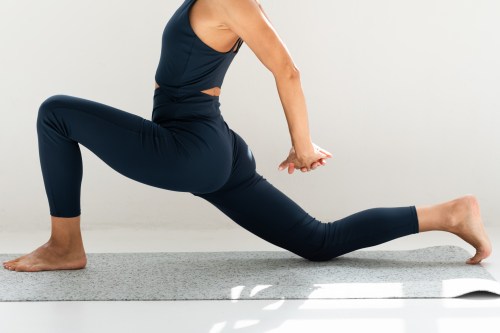Seeing the word “yin” tends to conjure its counterpart: yang. Visually, these two represent the complementary aspects of opposing sides of a circle. But in yoga, it’s totally possible to find the two polarities under the same roof, or, er, studio.
Experts in This Article
certified integrative health coach and registered yoga and meditation teacher
yoga teacher, educator, teacher trainer, and writer based in Queenstown, New Zealand
Here’s how they differ: Yang-style practices encompass fast-moving flows like the ones taught in sweaty vinyasa classes. And as you’d expect, yin is, well… not that. A yin yoga class will have you holding yin yoga poses (and holding, and holding them) with very different intentions from a faster-paced flow.
That difference is very intentional. “Yoga is rich tradition developed in India and other parts of South Asia, and the physical asana practice we are familiar with today is just a small part of it,” Rachel Land, a Yoga Medicine therapeutic specialist previously told Well+Good about restorative and yin yoga. “One of the teachings of the yoga tradition is that we seek equanimity: a balance between ‘sthira and sukha,’ roughly translated as effort and ease.” Yin yoga poses embrace the “ease” end of the equation, offering both physical and mental release.
What is yin yoga and what benefits does it offer?
“There are only 26 total yin postures, and while they look similar to yang poses one would take in a vinyasa class, they have slightly different names and intentions,” explains Lindsay Pirozzi, a New York City-based yoga instructor. “Since the emotional and energetic layers of the body are the main focus, [yin] practitioners experience a dramatic reduction of emotional imbalances, such as less anxiety, stress, frustration, and depression.”
Yin philosophy draws on principles from Traditional Chinese Medicine (TCM), and classes typically ask you to linger in passive asanas (or poses) for minutes at a time to target the deeper muscles along meridian lines as well as acupressure points. Think camel pose, which is often held for longer than might feel totally comfortable.
“The aim of this practice is not to stretch these tissues, but to ‘stress’ them by offering gentle, sustained traction, compression, or shearing. That load seems to result in improved connective tissue hydration and collagen synthesis, both of which lead to increased strength and resilience,” adds Land.
And while, yes, the practice can make you feel blissed out, it can also challenge you mentally. “Yin allows the mind to rest by producing a dream-like quality to the thoughts. A student can feel unsure of where one thought ends and one begins, and by allowing the mind to rest, the practice promotes clarity,” says Pirozzi. This is why yin is sometimes the modality used in yoga for sleep or morning yoga.
“Given its emphasis on stillness, it can also allow students to decompress from the pace of modern life, and explore their capacity to sit with and examine sensation,” says Land.
9 yin yoga poses to try
Ready to try it? Below, Pirozzi breaks down the ins and outs (and physically how to get in and out) of nine essential yin yoga poses.
1. Ankle stretch
- Begin in a kneeling position with your hips sitting on your heels. (If you have ankle or knee sensitivity, enter very mindfully—or skip this one altogether.)
- Place your hands just behind your feet and lean back into them, allowing your knees to lift off the floor. Keep your chest open. Hold for 90 seconds.
- To increase the challenge, try holding the knees with your hands and gently pulling them toward the chest.
2. Toe squat
- Begin in a kneeling position, sitting on your heels with the feet together.
- Tuck the toes under until your weight is on the balls of the feet (not the tippy-toes). Stay for 60 seconds. If you prefer to do two sessions of 30 seconds each, that’s okay too.
3. Butterfly
- From a seated position, bring the soles of your feet together and then slide them away from you.
- Fold forward, allowing your back to round. Lightly rest your hands on your feet or on the floor in front of you. Your head should hang down toward your heels. No stretching or reaching or striving is required—just allow your body weight and gravity to do the work, and feel the traction of tissue. Hold for three minutes.
4. Reclining twist (right and left)
- Lying on your back, draw both knees into your chest.
- Open your arms to either side and drop the knees to one side.
- Adjust the body so hips are stacked directly on top of each other, and then soften into your body (rather than forcing the twist deeper). Hold for three minutes on both sides.
- Rest in between each side, flat on your back.
5. Child’s pose
- Begin by sitting on your heels and then slowly fold forward, bringing your chest to your thighs and your forehead to the ground or to your forearms if it doesn’t touch down with ease. You can open your knees as wide as you would like, but as you settle into the shape do your best to soften your muscles. Hold for four minutes.
- Slide onto your stomach slowly, and rest there before the next posture.
6. Caterpillar
- Sitting with both legs straight out in front of you, fold forward, allowing your back to round. Keep your head heavy to allow the traction of your spine to occur. You can also sit on a cushion to elevate your hips and pelvis if that’s more comfortable. Hold for two minutes, and slowly round up to exit.
7. Straddle (dragonfly)
- From a sitting position, spread your legs apart until they won’t go any further. You can sit on a cushion to help tilt your hips forward.
- Fold forward, resting your weight onto your hands with your arms locked straight, or rest your elbows onto a block. Head is heavy, spine is naturally rounding towards floor. Hold for three and a half minutes.
8. Sleeping swan
- You can come into this pose either from downward dog or from quadruped pose (on hands and knees). Slide your right knee between your hands, and lean a bit to the right. If the knee feels fine, flex the right foot and move it forward; if the knee feels stressed, bring the foot closer in toward the right hip.
- Now, center yourself so your weight is even.
- Try tucking the back toes under and sliding the back knee away. Do this a few times until your right glute is on the floor or as low as it is going to get. You want to feel grounded, so the intention is not a squared hip, but a grounded hip. This may require bending your back knee slightly up toward the top of the mat.
- Recline slowly, try to stay for four minutes on each side, resting in between.
9. Savasana
- Whether you’re lying on the stomach, back or side, find a resting pose that is sustainable for you and rest your body for at least five minutes.
Frequently asked yin yoga questions
What’s the best approach to take to yin yoga?
Meant to decrease stress and anxiety, yin yoga poses should be calming. There are a few things to keep in mind to achieve this:
- Once you get into a pose, try not to move unless you’re in pain or aren’t feeling a stretch.
- It should take you 30 seconds to exit each yin pose, moving as effortlessly as possible out of the postures.
- It’s best to lie down on your back or stomach between each posture for 30 seconds to let your chi (or the energy of the body) recirculate.
- Breathe through your nose as naturally as you can the entire time to ensure the body stays in a restful state.
Who should do yin yoga?
With its emphasis on deep stretching, a yin yoga practice can be a helpful complement to anyone who engages in intense physical activity, whether you’re a competitive athlete or work a job that requires heavy physical labor. It’s ideal yoga for tight muscles. Yet while this style can increase flexibility and relaxation, there are times it should be approached with caution. “The sustained stress offered to our connective tissue also might not always be appropriate, for example during the early healing phase of soft tissue or joint injury or immediately before intense physical training,” Land says.
Is yin yoga okay for beginners?
With its exceptionally slow pace, yin yoga can be a welcoming yoga style for beginners—there’s little fear of getting left behind in class. All you need is a yoga mat, something to clean it with, and maybe a pillow. There are plenty of yin yoga videos on YouTube you can follow along to.
The come-as-you-are philosophy also makes yin yoga quite approachable. “In the simplicity of a yin pose, one size does not fit all,” yoga and movement coach Vanessa Michielon previously told Well+Good about yin yoga. “We do our best to develop our proficiency in what we do, but we also learn how to accept our limitations and work around them, instead of blaming our bodies for what we cannot be.”
Sign Up for Our Daily Newsletter
Get all the latest in wellness, trends, food, fitness, beauty, and more delivered right to your inbox.
Got it, you've been added to our email list.











